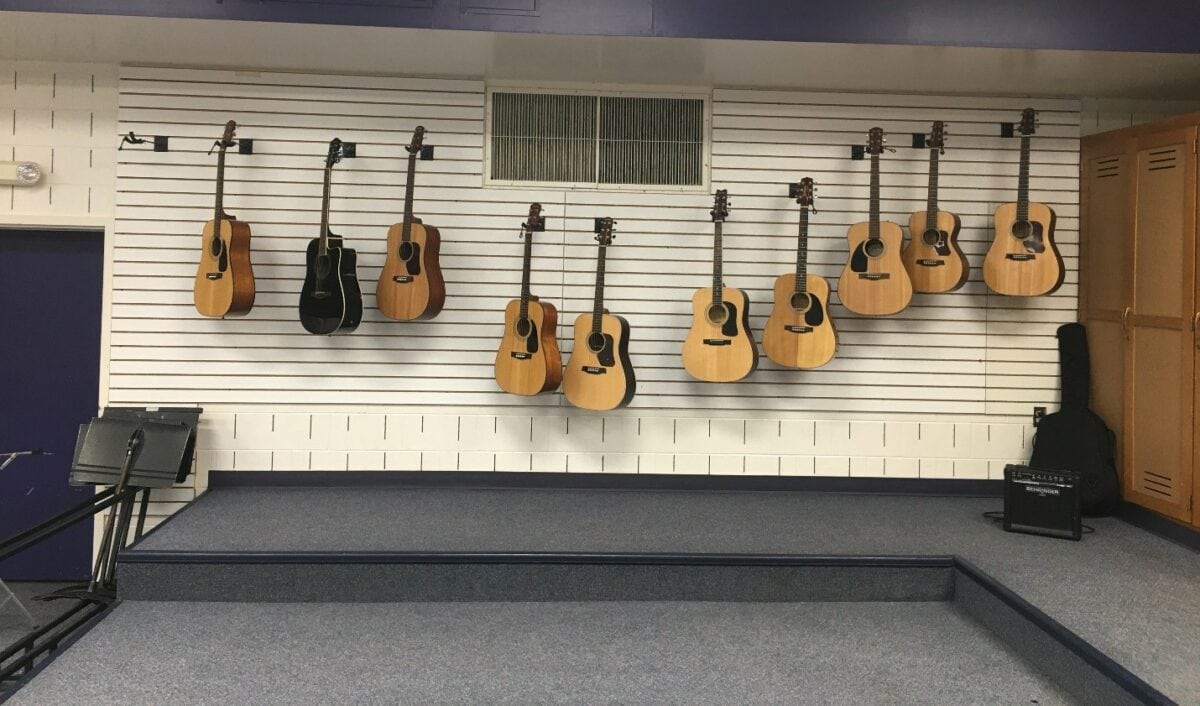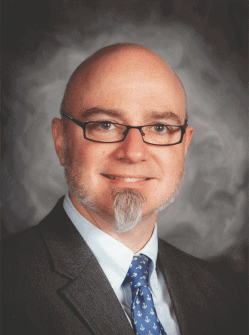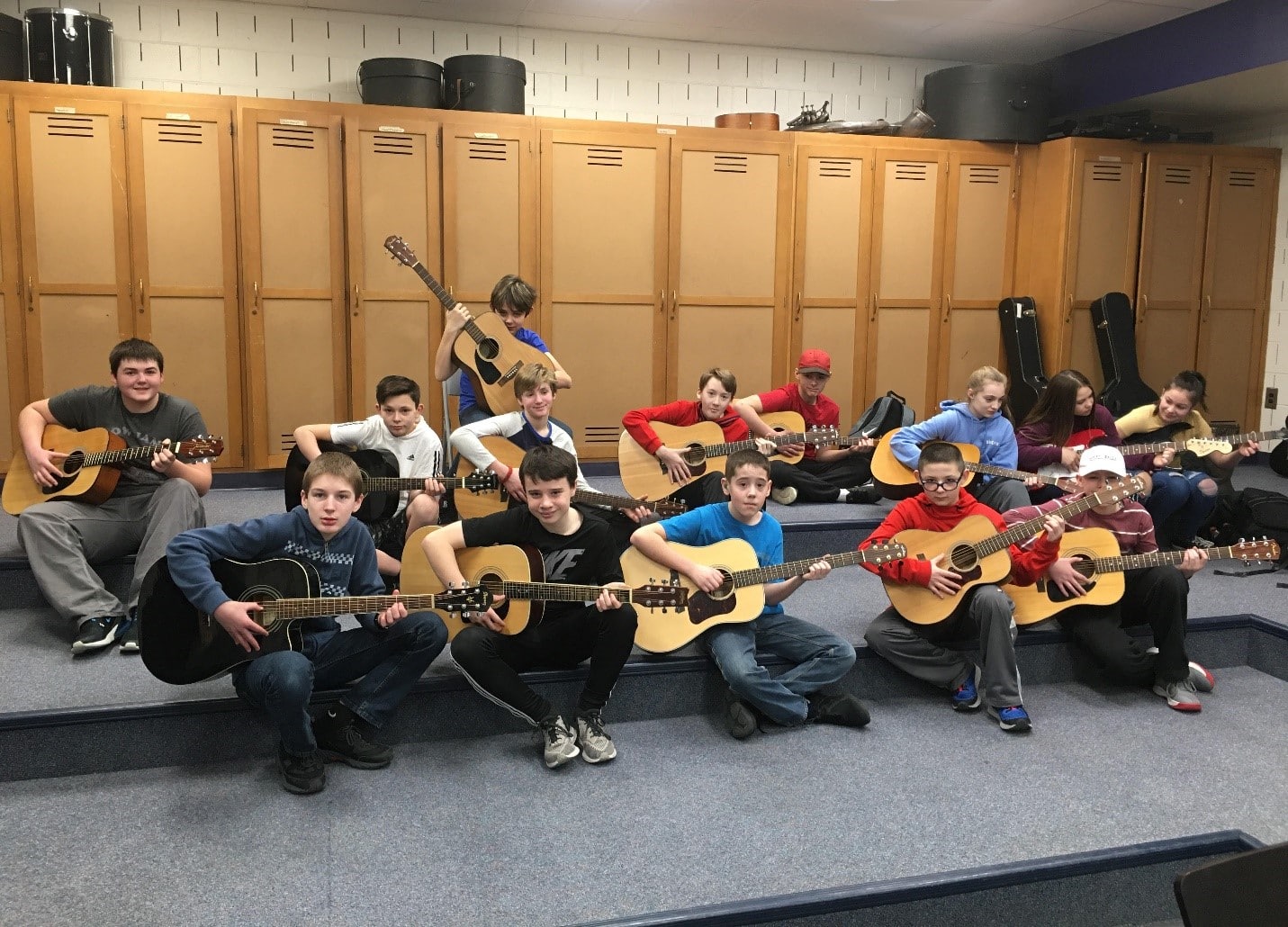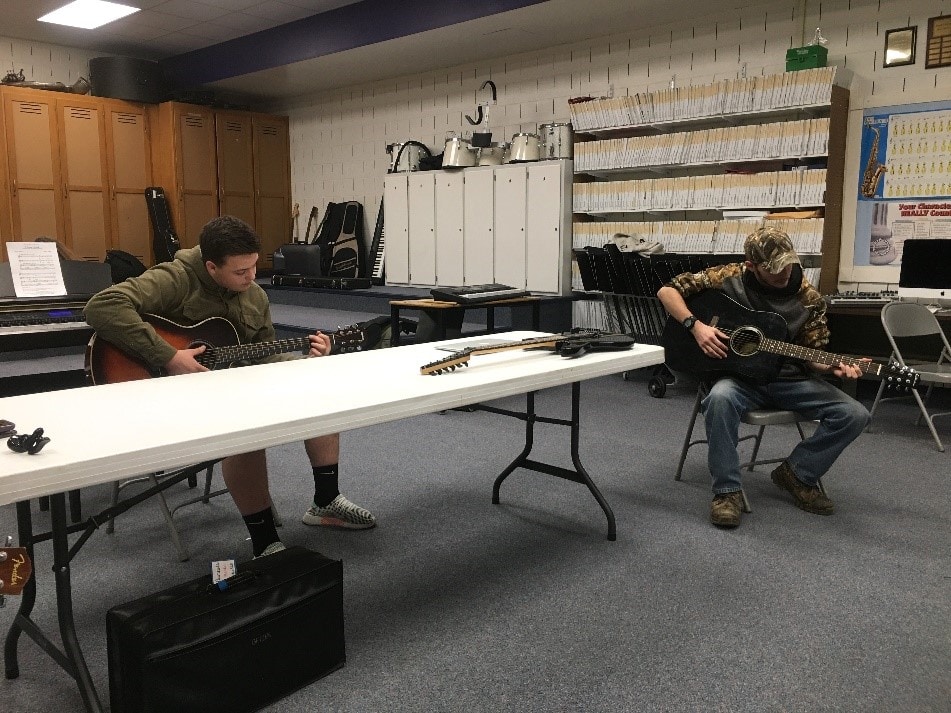/ News Posts / Guitar Class in the Green Mountain State: Vermont
Guitar Class in the Green Mountain State
Number 49: The State of Vermont
By Thomas Amoriello Jr.
NAfME Council for Guitar Education Immediate Past Chair
Images in this article were taken before the closure of schools due to the COVID-19 pandemic.
In this edition of “50 States of Guitar Class,” the NAfME Council for Guitar Education speaks with music educator Cindy Hall of Oxbow High School in Bradford, Vermont. She has found unique ways to incorporate the guitar into the music program in Vermont. Thank you, Ms. Hall, for sharing your knowledge with the NAfME membership.
Please tell us about your school and overall music program.
Oxbow High School is a small rural school with about 300 students in grades 7–12. Middle school students take a 9-week rotation course in music and also have the opportunity to be in band and/or chorus. High school students can take band, chorus, Guitar I, Guitar II, American Popular Music (a history/listening course), modern band, or an independent study.
Please tell us about your own personal musical background growing up and your collegiate experience.
I went to a large regional high school in northern Vermont with a strong music program, where I played horn in band and trombone in jazz band. I went on to get a BA in Music at Bowdoin College and a BM in Music Education from the University of Southern Maine, studying horn at both schools. I taught myself a bit of guitar in high school—but just melodically—no chords. That was my only guitar experience until I started teaching at Oxbow.
How do the guitar family of instruments fit into your teaching?
Some of my most rewarding moments have come from teaching guitar class. I especially love when a kid takes guitar class only because they need an arts credit and ends up staying in from lunch every day just to play, or buying their own guitar so they can continue after the class is done or they graduate. Another aspect of teaching guitar that I love is the fact that I can often recruit guitar students to join chorus or learn a band instrument once they have discovered a passion for music and have discovered that the music room is an engaging place to be.
What obstacles did you face when you were first hired at your school? Now?
The biggest obstacle when I started was scheduling—and it remains scheduling. Ensemble classes are most affected just because of the nature of them—the need for balanced instrumentation and yearly participation. Kids can come and go from guitar classes each semester without affecting the ensemble, as we do more individualized work in guitar class.
What kind of classes related to the guitar do you teach?
We have offered a Guitar I class at Oxbow for more than twenty years now. It meets every day for a semester. Some years we offer two sections, and for the last fifteen years or so we have also offered Guitar II. Every 7th grader takes a music rotation class (9 weeks), and the guitar and bass factor heavily into that curriculum. This year we are offering a high school-level modern band class for the first time, which will include guitar and bass.
What would you like to say to the non-guitarist music educator who is about to or interested in incorporating the guitar into their program?
It doesn’t matter if you’ve never played guitar—there are so many resources out there! YouTube is a goldmine for guitar instruction. Teach yourself over the summer, and then stay one step ahead of the kids. Every year your skills and confidence will build, and pretty soon you’ll feel as comfortable in front of a class of budding guitar players as you are in front of a band, chorus, or general music class.
Do you have any success stories you would like to share about students (musical and non-musical)?
I have had a number of students continue with guitar at a high level as singer-songwriters, luthiers, rock band front men, and open mic regulars—but many, many more who end up buying their own guitars and playing for their own enjoyment or with friends. I think I’m most excited about that population because I know they have acquired a skill and love of music that will last the rest of their lives—and many of those kids started high school never intending to take a music class.
What do you tell your talented students who are planning to pursue music or guitar studies in high school or college after they finish with you?
Keep an open mind and network with as many people as you can. There are so many paths to take in the field of music, and oftentimes you can end up doing something music-related that you love but which you never imagined yourself doing—audio engineering, running a venue, music publishing, or organizing festivals. It’s often the connections you’ve made that will lead you down some wonderful paths. Also—college is not for everyone . . . nor is music the best option for a major in every case.
Do you have any networking or advocacy tools that have worked for you promoting your program that would help other educators?
Word-of-mouth is important. Kids talk. If you build a program that is exciting, engaging, relevant, and challenging, word will spread, and kids will sign up for your class.
What kind of future do you see for guitar in music education in Vermont schools?
I see it getting stronger every year. More and more schools are offering guitar classes and we are seeing workshops regularly at state music education conferences. The Little Kids Rock/Modern Band program is starting to take hold in the state, which will give educators a strong toolkit with which to dive into teaching guitar and bass. I am very fortunate that my feeder school colleague, Heidi Allen, started the first Little Kids Rock program in the state and has been very active in advocacy for the program here in Vermont.

Photo courtesy of Cindy Hall
What type of lesson plans have you done for your classes that may be unique?
I have my own curriculum for guitar classes that includes everything I think kids should know and be able to do in order to be functional guitar players and expressive musicians. Some of the assessment pieces are songs I choose that cover a specific skill such as power chords, fingerpicking, or specific root position chords. Other assessments involve students performing a song of their own choice. I require Guitar I kids to learn chord diagrams and tablature, as well as musical roadmaps and music terminology—but we don’t cover standard notion until Guitar II.
Do you participate in any musical performances or activities outside of your public school teaching duties?
When I first started teaching, I was very active as a horn player around the state. In the last decade, my outside musical endeavors have morphed more into music business. I am the tour manager for a national touring act, The Slambovian Circus of Dreams. I advance gigs, am the liaison with the booking agent, and am road manager/tour merchandiser for shows. I also do website, social media, and online store work for the band. The hands-on experience with real-life music industry experiences has paired perfectly with my classical background, and I feel like I can bring a very well-rounded perspective to students.
Any last thoughts to conclude our interview?
Music education is evolving, and more and more schools are teaching guitar, technology, keyboard, or other classes that go beyond traditional ensemble classes. This is a wonderful trend. I grew up with traditional ensembles and love them, and they occupy a crucial place in the overall music program of a school—but having the other options is important.
Read more “Guitar Class in 50 States” articles:
- Number 50: The Granite State (New Hampshire)
- Number 48: The Mountain State (West Virginia)
- Number 47: The Hoosier State (Indiana)
- Number 46: The Mount Rushmore State (South Dakota)
- Number 45: The Pine Tree State (Maine)
- Number 44: The Badger State (Wisconsin)
- Number 43: The Constitution State (Connecticut)
- Number 42: The Evergreen State (Washington)
- Number 41: The Pelican State (Louisiana)
- Number 40: The Beaver State (Oregon)
- Number 39: The Equality State (Wyoming)
- Number 38: The Empire State (New York)
- Number 37: The Old Line State (Maryland)
- Number 36: The Centennial State (Colorado)
- Number 35: The Bay State (Massachusetts)
- Number 34: The Sooner State (Oklahoma)
- Number 33: The Prairie State (Illinois)
- Number 32: The Hawkeye State (Iowa)
- Number 31: The Volunteer State (Tennessee)
- Number 30: The Palmetto State (South Carolina)
- Number 29: The Natural State (Arkansas)
- Number 28: The Tar Heel State (North Carolina)
- Number 27: The Magnolia State (Mississippi)
- Number 26: The Peace Garden State (North Dakota)
- Number 25: The Treasure State (Montana)
- Number 24: The First State (Delaware)
- Number 23: The Buckeye State (Ohio)
- Number 22: The Yellowhammer State (Alabama)
- Number 21: The Sunflower State (Kansas)
- Number 20: The Great Lakes State (Michigan)
- Number 19: The Lone Star State (Texas)
- Number 18: The Bluegrass State (Kentucky)
- Number 17: The Golden State (California)
- Number 16: The Show-Me State (Missouri)
- Number 15: The Keystone State (Pennsylvania)
- Number 14: The Last Frontier State (Alaska)
- Number 13: The Beehive State (Utah)
- Number 12: The Peach State (Georgia)
- Number 11: The Cornhusker State (Nebraska)
- Number 10: The Gem State (Idaho)
- Number 9: The Old Dominion (Virginia)
- Number 8: The Aloha State (Hawaii)
- Number 7: The Land of Enchantment (New Mexico)
- Number 6: The Sunshine State (Florida)
- Number 5: The Grand Canyon State (Arizona)
- Number 4: The Ocean State (Rhode Island)
- Number 3: The North Star State (Minnesota)
- Number 2: The Silver State (Nevada)
- Number 1: The Garden State (New Jersey)
About the author:
 Thomas Amoriello Jr. is the Immediate Past Chair of the NAfME Council for Guitar Education and is also the former Chairperson for the New Jersey Music Education Association. Tom has taught guitar classes for the Flemington Raritan School District in Flemington, New Jersey, since 2005 and was also an adjunct guitar instructor at Cumberland County College, New Jersey, for five years. He has earned a Master of Music Degree in Classical Guitar Performance from Shenandoah Conservatory and a Bachelor of Arts in Music from Rowan University. He is the author of the children’s picture books A Journey to Guitarland with Maestro Armadillo and Ukulele Sam Strums in the Sand, both available from Black Rose Writing. He recently made a heavy metal recording with a stellar roster of musicians including former members of Black Sabbath, Whitesnake, Ozzy Osbourne, Yngwie J. Malmsteen’s Rising Force, and Dio that was released on H42 Records of Hamburg, Germany. The record released on 12-inch vinyl and digital platforms has received favorable reviews in many European rock magazines and appeared on the 2018 Top 15 Metal Albums list by Los Angeles KNAC Radio (Contributor Dr. Metal). Visit thomasamoriello.com for more information.
Thomas Amoriello Jr. is the Immediate Past Chair of the NAfME Council for Guitar Education and is also the former Chairperson for the New Jersey Music Education Association. Tom has taught guitar classes for the Flemington Raritan School District in Flemington, New Jersey, since 2005 and was also an adjunct guitar instructor at Cumberland County College, New Jersey, for five years. He has earned a Master of Music Degree in Classical Guitar Performance from Shenandoah Conservatory and a Bachelor of Arts in Music from Rowan University. He is the author of the children’s picture books A Journey to Guitarland with Maestro Armadillo and Ukulele Sam Strums in the Sand, both available from Black Rose Writing. He recently made a heavy metal recording with a stellar roster of musicians including former members of Black Sabbath, Whitesnake, Ozzy Osbourne, Yngwie J. Malmsteen’s Rising Force, and Dio that was released on H42 Records of Hamburg, Germany. The record released on 12-inch vinyl and digital platforms has received favorable reviews in many European rock magazines and appeared on the 2018 Top 15 Metal Albums list by Los Angeles KNAC Radio (Contributor Dr. Metal). Visit thomasamoriello.com for more information.
Did this blog spur new ideas for your music program? Share them on Amplify! Interested in reprinting this article? Please review the reprint guidelines.
The National Association for Music Education (NAfME) provides a number of forums for the sharing of information and opinion, including blogs and postings on our website, articles and columns in our magazines and journals, and postings to our Amplify member portal. Unless specifically noted, the views expressed in these media do not necessarily represent the policy or views of the Association, its officers, or its employees.
Catherina Hurlburt, Marketing Communications Manager. June 5, 2020. © National Association for Music Education (NAfME.org)
Published Date
June 5, 2020
Category
- Ensembles
Copyright
June 5, 2020. © National Association for Music Education (NAfME.org)





